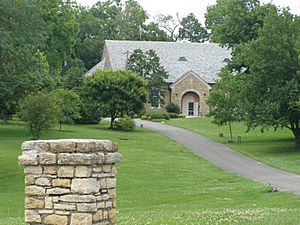Cane Ridge, Kentucky facts for kids
Quick facts for kids |
|
|
Cane Ridge Rural Historic District
|
|
| Location | Bourbon County, Kentucky |
|---|---|
| Architectural style | Federal Style, Classical Revival |
| NRHP reference No. | 02001463 |
| Added to NRHP | June 25, 2003 |

Cane Ridge is a special place in Kentucky. It was the location of a huge religious gathering in 1801. This event was called the Cane Ridge Revival. Thousands of people came together for this important meeting.
The Cane Ridge Revival was a big part of the Second Great Awakening. This was a time when many people in the United States became very interested in religion. The revival was led by many different preachers. These included Presbyterian, Methodist, and Baptist leaders. People showed their faith in strong ways, like speaking in unusual languages or showing great emotion.
Cane Ridge is found in Bourbon County, Kentucky. It is close to the town of Paris. The explorer Daniel Boone gave the ridge its name. He saw a type of bamboo plant growing there. The original Cane Ridge Meeting House was built in 1791. It is thought to be the largest single-room log building in North America. There is also a burial ground with a large unmarked section.
A Christian church group met at Cane Ridge for many years. They left the Presbyterian Church in 1804. Barton W. Stone was their minister. He was a key leader of the Christian Church. This place was so important to him that he was buried there after his death.
The Cane Ridge Revival helped start a movement called the Restoration Movement. Barton Stone and other ministers left the Presbyterian Church. They then created the Christian Church in 1804. Another part of this movement was the Disciples of Christ. This group was led by Alexander Campbell. In 1832, Stone and Campbell decided to work together. Later, other groups like the Churches of Christ also developed.
The Historic Meeting House
The Christian Church used a log building as their meeting house. Over time, it was updated many times. In the 1920s, the church group stopped meeting there regularly. The building then became unused for a while.
Later, people who cared about history helped restore the building. They were mostly from the Disciples of Christ group. They built a stone structure around the meeting house. This shrine helps to protect the old log building.
Restoring the Slave Gallery
The meeting house once had a special section called a slave gallery. This was a balcony where enslaved people could sit during services. Restoring this gallery was a very old project in the United States.
In the 1820s, the church group removed the slave gallery. They did this because they supported ending slavery. When people began restoring the building in the 1930s, they put the original gallery back. It had cherry wood railings. The gallery was found in a local barn. It had been used to store hay for over 100 years.
The meeting house is still used today as a living church. You can arrange a guided tour with a curator.
-
The original Cane Ridge Meeting House inside the Stone Memorial Building
Barton Warren Stone Museum
The Barton Warren Stone Museum is also at Cane Ridge. It holds many interesting items. You can see things from the church group and Barton W. Stone's family. There are also items about the Stone-Campbell movement. The museum also displays old farm tools and household items.
The museum is open only during the summer months. It also has the office for the Cane Ridge Preservation Projects. There is a book shop there too.




